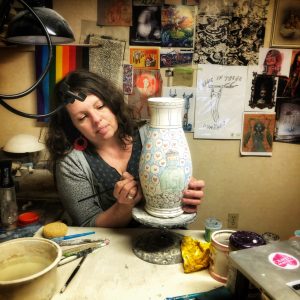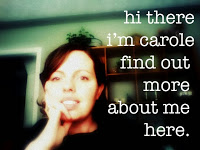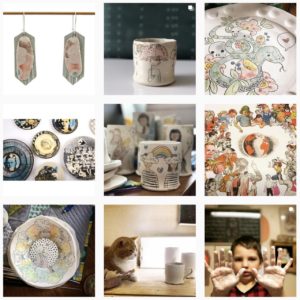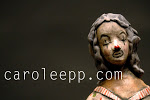Wow the last week has flown by and I have yet to post about the conference, so it’s time to get going…
My first day in Halifax I began with a bit of gallery hopping before the conference started that afternoon and took in, among other things the exhibition “On the Table” at the Art Gallery of Nova Scotia, which was a fairly good overview with a nice catalogue, fun to go through, and definitely worth it, but the mood I was in it wasn’t challenging my controversial, I’m here at this conference to think and be inspired nature.
There was however works by Shary Boyle‘s in the Sobey Art Award exhibition, which were great to finally see in person.
As luck would have it later that day I found all the controversy I could have asked for. At St. Mary’s University the gallery was presenting an exhibition of Leopold Foulem‘s work which had enraged some students since it’s opening reception and that day was hosting a discussion panel about the work inviting the public to attend and voice opinion about the exhibition with the artist in attendance.
The specific piece in question was one of his Santa series which made reference to the history of ceramic collectibles produced which represented stereotyped and racist imagery of African Americans. The piece by Leopold was a santa glazed in matte black with large glossy red lips and turned into, through the inclusion of found objects, a teapot. I’m choosing not to post an image of the work here as I am interested in the debate raised by the work, yet do not wish to cause any further upset in the public sphere through distributing imagery of the work in question. A web search of Leopold’s work will most likely take you to the specific piece or others in which he makes similar references.
So there were a few things about the discussion that I found interesting as a practicing artist. Firstly the importance of being responsible for the work you put out into the public sphere, and it’s adequate contextualization for the large variety of potential audiences that will view the work, either in person or in print or online. The crowd that attended the discussion drew obviously from two groups, one an audience academically knowledgeable in craft history and practice and the other, an audience made up of a more general public which although highly educated and well spoken, were not versed in ceramic history and context. To the latter group this work simply and without proper reasoning referenced a very hurtful and oppressive past, which still resonates in contemporary context on a daily basis. Being confronted with the imagery in a public gallery to them spoke of further stereotyping and oppression, rather than a reference to a disturbing past with the aim of furthering dialogue regarding the issue. The pairing of racial stereotype with the imagery of Santa Claus, a made-up commercialized figure also made the historical reference/narrative seem imaginary, or less serious.
Basically an issue to be dealt with was whether it was possible to separate representing racism from being racist. And was it possible for an artist of Caucasian dissent to work with such visual imagery and ideas with a thorough and respectful understanding of context and impact of such imagery.
While admittedly Leopold was confronted by a group of very angry audience members who were very challenging and questioning of his motives with the work, I felt that the artist, and this is regardless of how I feel personally about the artist or the work, did a poor job of properly contextualizing his work for the audience. He continued to re-iterate that the work was about the art/craft debate and the stereotypes and prejudices that exist in that discussion, but could not justify or clarify his motivation for the use of this particular visual imagery. He stated that he did not like to self-censor his work and that he often worked intuitively with ceramic imagery and history. I guess that made me question my own practice as I do self censor, well maybe better stated as self edit works after they are made based on how I perceive them to be read by the viewer. If a work has the potential to be mis-interpreted to the extent of having an opposing reading to that which was intended I would be likely to edit the piece. That is not to say I’m not interested in multiple readings of work, in fact I love to discover new interpretations that viewers have of my work, but when dealing with more charged and confrontational imagery, one has to be more careful and responsible in my opinion.
I guess what I really noticed in the discussion was the way in which the exhibition was limited in its ability to reach a larger, less elitist audience with the theme and content of the work due to poor contextualisation of the work by the artist and the gallery. But then should the work not speak for itself? Must we question the role of the gallery/artist statement to frame the work and is that what we want to rely upon to get our ideas out? Or is it the work itself that should speak? So what happens when that backfires and the work says things we don’t intend, when it takes our audience down a path we did not wish for them to travel down? Are we responsible for this turn off course?
One of the audience’s comments struck me in reference to my own figurative work where in I try to speak of global humanitarian issues through my own framework and positioning relative to the events rather than from a stance of empathy or mere re-representation which I fear can further victimize. He stated that being apologetic for history or events but still using that particular imagery and stereotypes from your position of privileged doesn’t make it acceptable, since you can’t remove yourself from that distance and that position of power and privilege. Does this mean though then that only minority artists can speak of racial issues, only those in war torn countries can speak of the horrors of war? Must we as artists only speak to issues of which we have first hand knowledge? For me that would be problematic as I want to engage with larger issues than the pettiness of my own privileged life. I think that the engagement and presentation of different perspectives is what contributes to greater understanding of our humanity and what is taking place in the world; also providing the potential for future change, growth and the end to such problems and injustices. But what I really walked away with that afternoon was a understanding of the grave importance of contextualizing your work, of being responsible for any and all readings of that work, and of the artists’ responsibility to their audience, and not just the ideal audience which will bring a similar wealth of experience and knowledge to the work, but to any audience member, with their own perspectives and history. I guess it reminded me about why I sometimes despise academic art for it is elitist and limited in its scope. It is the reason that I love to make functional work as well as sculptural work, because I feel a need to invest in dialogues that impact our everyday, which we can each relate too, contribute to and grow from.
I don’t know, there is still a lot for me to digest from that discussion. And alot of questions I need to answer for myself, especially now as I’m in the process of developing a new exhibition of figurative works, engaging a variety of topics, many controversial. I know that in the back of my mind at all times will be my responsibility as an artist, in this privileged role, to say something of interest and relevance in an appropriate and respectful manner.
All in a day’s work right?
More about the conference to come so stay tuned…











“Oh Canada (ah) Whew! Too much to think about. Your closing thoughts are like an echo.
Firstly ,what is it about Canada,something in the water perhaps? Or is it related to the strain of polio which affectedNeil an Joni all those years ago. Seriously now, I’ve always been interested in the depth of music which has come out of Canada and am now seeing a similar rigour and engagement in its ceramics which is in marked contrast to much of the work from below the border.
Self-censoring is a slippery slope! The audience IS the audience.Work can provoke or affront as long as that isn’t the full extent of it.
Anecdote: I did some graphics a while back for diability learning. One of my roughs was a winged wheelchair.One of the clients was very upset by what she saw as fsacist imagery. She had fled from Chile under Pinochet.The kids in wheelchairs saw it as a life affirming positive image! Go fiure.
something in the water indeed, i think i developed the disease while in grad school in australia!!
i agree that self censoring is a slippery slope, which is why i said self editing, but maybe it isn;t all that different in the end… I always think that the artist’s role is to put whatever out there that needs to be said or shown in order to get people thinking/talking/acting. I guess i just also feel that you have to be responsible for any negative feedback that comes back at you, which not to single out, but Leopold in my opinion didn’t do. he didn’t seem (and this is my personal opinion and maybe not how he saw it go down) willing to accept that there was this other offended reading to his work. He seemed dismissive of the reading since it was not how he intended it and that i have a problem with. If i had someone offended to my work I would be interested in where the communication broke down and would have tried to devise ways of recontextualising or re-presenting the work to better suit the positive/proactive intent i wanted to present. Or maybe i’m a pushover that considers my audience too much, maybe my focus when making is off and perhaps it impacts how my work turns out in the end…good or bad. too mcuh to think about…
good anecdote though, proving it;s hard to use visual language as each culture/generation has different readings.
Great post cazza. I’ll be back, with more to say than i can manage right now!
Great, thought- provoking posts (thanks for the previous post by the way!) I don’t think the artist can be responsible for every reading of the work, as Gerry pointed out no-one knows what an audience member will see. I always have this dilemma of commenting on issues that I am not directly involved in. But I am a member of society and racism is a problem in my society. It does affect me and I see and hear it even though I am not black. It is a tricky one though as when I see “feminist” works done by male artists I often find myself inwardly scoffing and thinking “What would he know about it?”
The role of the arts is to examine the world and provide a small window into that examination. To that effect I guess we should all keep making and keep questioning ourselves and other artists and artists should keep talking.
Hi Carole, I’m a bit behind with the blogs but what an important post you write.
My opinion is that every opinion is floored in a kind of self- interest..BUT..(I fear)that in saying this I could be boosting my own self-love, self-regard,self-seeking,self-absorption,self-obsession, self- conceit,..ego..
it never ends , which could be a happy thing?